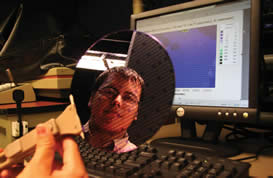Flexible displays
US researchers have collaborated to develop what they claim is the first prototype of an affordable, flexible electronic display.
Researchers at HP, working with colleagues at the Flexible Display Center (FDC) at Arizona State University (ASU), have developed prototypes of affordable, flexible electronic displays.
Mass production of such displays could enable the production of notebook computers, smartphones and other electronic devices at much lower costs since the display is one of the more costly components.
What is more, from an environmental standpoint, the displays use up to 90 per cent fewer materials by volume than conventional displays.
The unbreakable displays were created by the FDC and HP using self-aligned imprint lithography (SAIL) technology invented in HP Labs, HP’s central research arm.
SAIL technology enables the fabrication of thin film transistor arrays on a flexible plastic material in a low-cost, roll-to-roll manufacturing process.
This allows for more cost-effective continuous production, rather than batch sheet-to-sheet production.

SAIL is considered 'self-aligned' because the patterning information is imprinted on the substrate in such a way that perfect alignment is maintained regardless of process-induced distortion.
Register now to continue reading
Thanks for visiting The Engineer. You’ve now reached your monthly limit of news stories. Register for free to unlock unlimited access to all of our news coverage, as well as premium content including opinion, in-depth features and special reports.
Benefits of registering
-
In-depth insights and coverage of key emerging trends
-
Unrestricted access to special reports throughout the year
-
Daily technology news delivered straight to your inbox










Water Sector Talent Exodus Could Cripple The Sector
Maybe if things are essential for the running of a country and we want to pay a fair price we should be running these utilities on a not for profit...